Day 1 of a three day long weekend of tours today. The plan was to spend some of the time looking for a selection of our regular winter birds and some of the time trying to find owls. After two foggy days, it seemed like it might be more of the same today but then, contrary to all the forecasts, the sun came out! It was a lovely day to be out.
Holkham was our first destination this morning. As we turned into Lady Anne’s Drive, we could see several thrushes out on the wet grass feeding around one of the pools. We pulled up for a quick look and could see they were mainly Fieldfares along with a couple of Redwings too. A short distance further on, a little covey of Grey Partridges was feeding in the grass on the other side.
As we got out of the car at the top of the Drive, a couple of Marsh Harriers flew low overhead, presumably heading out from the roost to feed. The first was a male, quite a dark one, possibly a young bird although greyness does not always correlate with age in male Marsh Harriers! This was closely followed by a female, dark brown with paler creamy yellow head and shoulders.
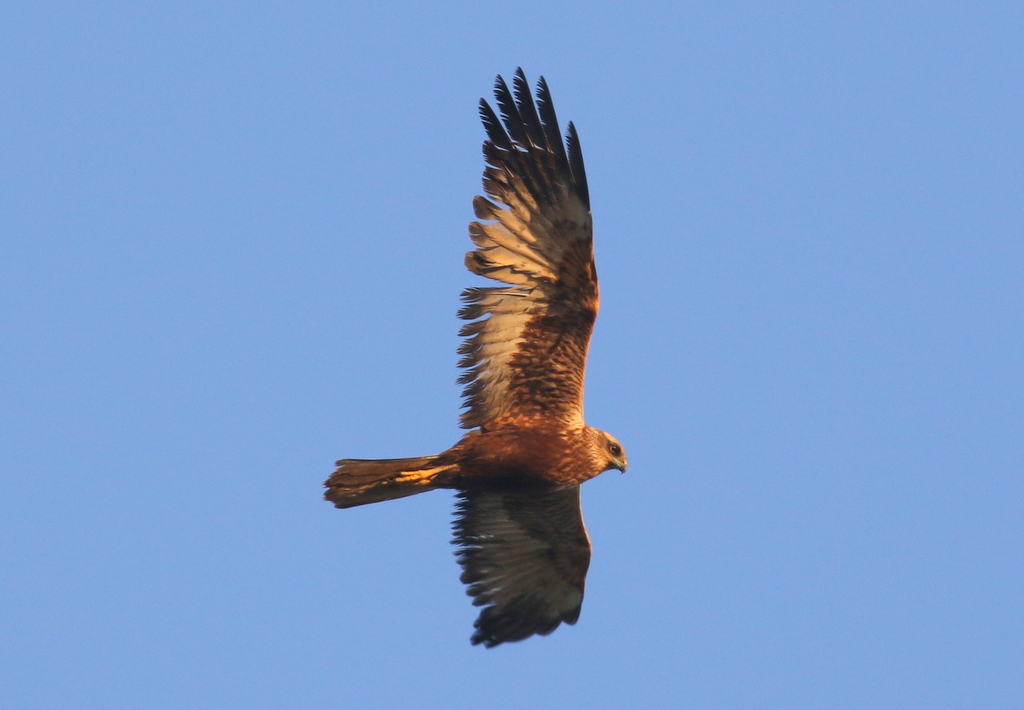
There were plenty of wildfowl here too. Little groups of Pink-footed Geese flew over calling, before landing out in the fields – we could hear their squeaky calls, higher pitched than the more familiar Greylags. A larger flock of Brent Geese arrived from the direction of Wells. On the other side, a big group of Wigeon was flushed by another passing harrier and flew round whistling, before landing back down in the grass.
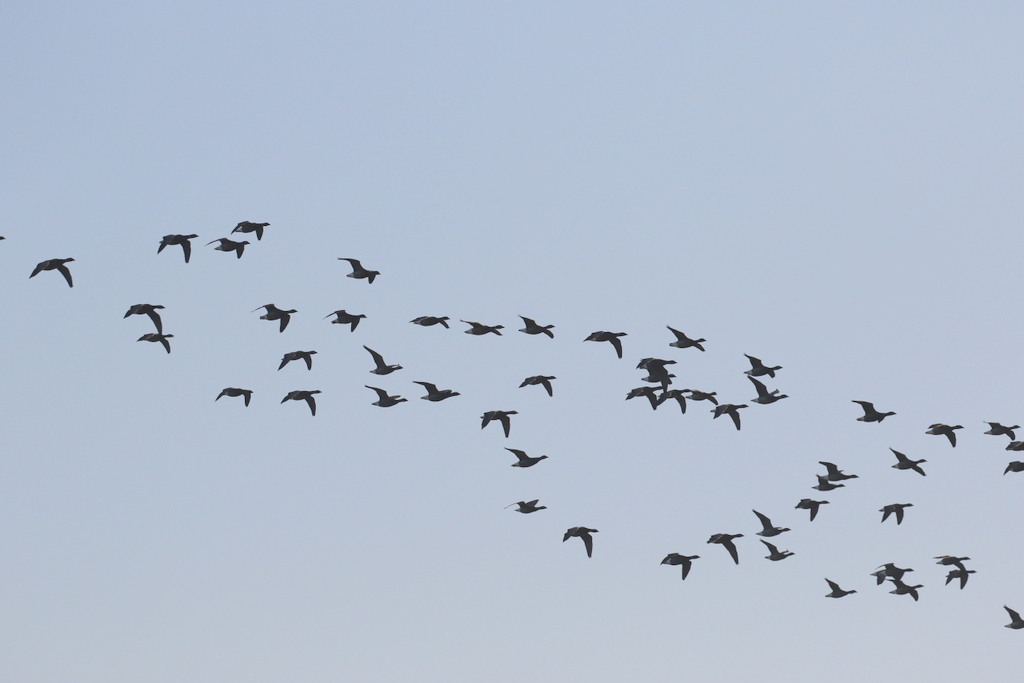
As we made our way through the trees towards the beach, a Treecreeper was calling in the pines. We walked east along the path on the edge of the saltmarsh. A couple of Skylarks flew over calling and a big flock of Meadow Pipits flushed from out in the vegetation.
There was no sign of any Shorelark in their usual favoured spot out on the saltmarsh. We continued on a little further, scanning all the time, and finally spotted one in the distance on a strip of shingle in a gap in the dunes. A couple walking their dog were just coming off the beach beyond, walking straight towards it. We all had a quick look at it through the scope in case it flushed, but thankfully it stayed put.
We walked over half way towards it and stopped again for a closer look through the scope. We could see its creamy yellow face and black bandit mask. We could see now that the Shorelark appeared to be on its own and was rather nervous. We could hear it calling, presumably trying to locate the rest of the group here. Then it flew over us and landed back on the saltmarsh where we had just been. We walked back, but the Shorelark was calling all the time now. It took off and circled round over the saltmarsh, before flying off over the dunes to the beach.

Out on the beach, we could feel the warmth of the sun, which was just high enough to reach here over the pines behind. Scanning the sea, we found a group of Red-breasted Mergansers. Several smart males were chasing round after a single female, showing off their spiky haircuts.
There were lots of Cormorants standing on the sand and several more diving out on the sea, along with a handful of Great Crested Grebes. Looking carefully, we managed to find a single Red-throated Diver with them, but it was hard to get onto, diving all time. There were not many waders on the beach, just a few Oystercatchers, but three Sanderling flew past just offshore, shining white in the morning sunshine.
As we walked back towards Holkham Gap, a movement in the dunes just below the trees caught our eye. A female Stonechat had landed down in the marram grass. It flew up and very helpfully posed in front of us on the top of a young pine.
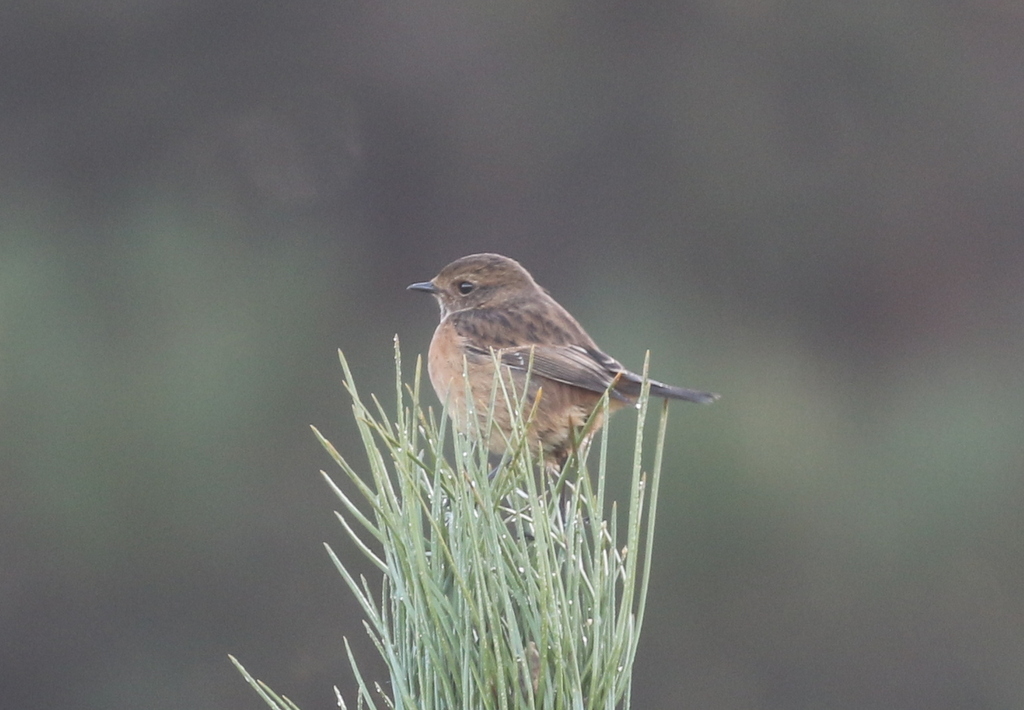
Back through the pines, we headed west along the track on the other side of the trees. It was fairly quiet until we reached Salts Hole. Here, we could see two Little Grebes asleep on the edge of the reeds on the far side, in the sun. A couple of Coot were busy diving, and a female Goldeneye swam out into the middle to join them. A big flock of Wigeon flushed from the grazing marsh behind, and several flew in and landed on the water whistling noisily.
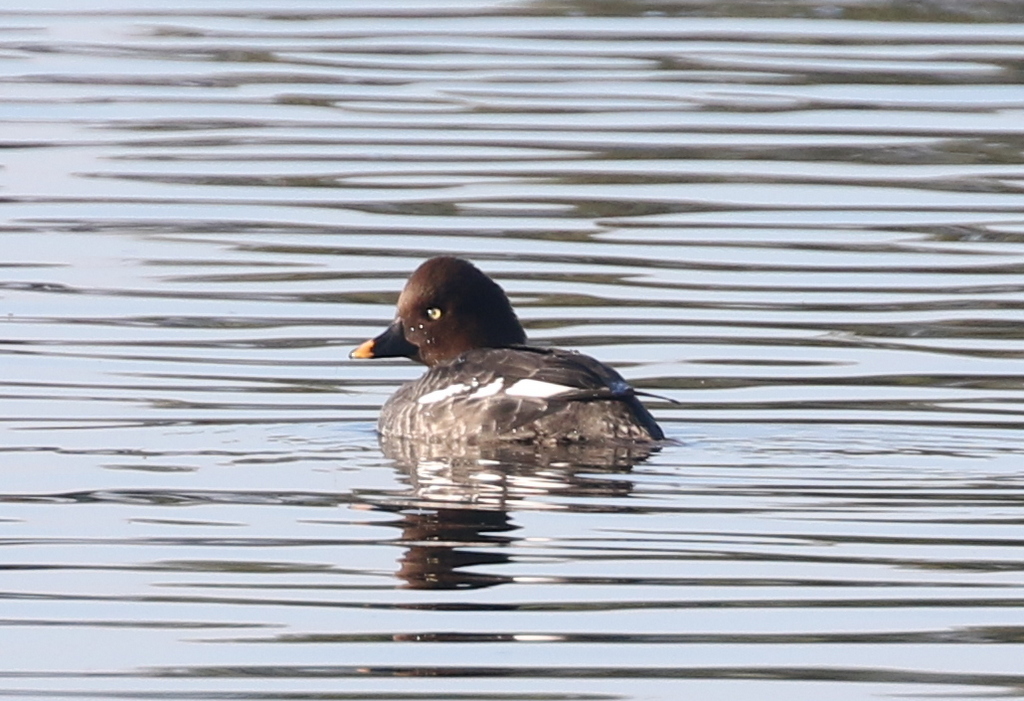
The drawback of it being such a lovely morning was that at Washington Hide, we were looking into the sun. There was no sign of anything on the pool in front of the hide today, although we did hear a Bearded Tit calling from the reeds.
One of the Great White Egrets then appeared, landing on the grazing marsh just to the west of us. A Grey Heron flew across and chased after it – a good size comparison, we could see that there was nothing between them. The Grey Heron seemed to lose interest pretty quickly and the Great White Egret landed again, before walking down into one the reedy ditches.
We carried on our way west. We were almost up to the crosstracks when we came across a big flock of tits. We heard the Long-tailed Tits first and they dropped out of the pines and made their way through the bushes across to the other side of the track. They were followed by several Coal Tits and Goldcrests. A few seconds later, a rather wet Coal Tit flew back to the bushes on the edge of the pines and perched in the top of one preening. A wet Goldcrest followed. They had obviously been down for a drink and a bathe in one of the ditches.
As we opened the windows of Joe Jordan Hide, we could see lots of geese on the grass just below. They were mainly Greylags, but a single Pink-footed Goose was with them. It was a good comparison – we could see the large orange carrot of a bill on the Greylag Geese compared to the more delicate and darker bill of the Pinkfoot.

There were more geese further back, feeding on the grass on the top of the old fort. Through the scope we could see they were White-fronted Geese – we could see the distinctive white surround to the base of their bills and their dark belly bars. These birds come here from their breeding grounds in Russia for the winter in very variable numbers. There have been rather few present so far this winter but numbers have just started to increase, possibly in response to colder weather out on the continent.
Another Great White Egret appeared, landing out in the wet grass between the hide and the pool. It looked huge next to the Greylag Geese feeding nearby. Through the scope we could see its long, dagger-shaped yellow bill.
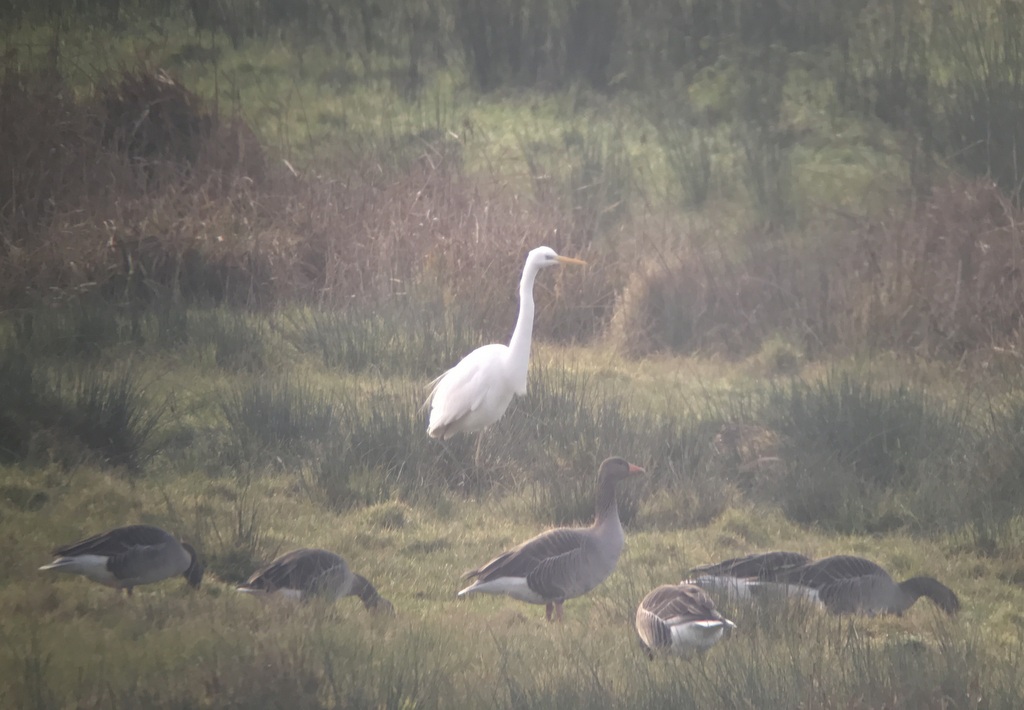
There were a few ducks around the pool beyond, mainly Teal along with a few Shoveler. A couple of Mistle Thrushes landed on the grass below the hide, feeding in amongst the molehills with a Fieldfare. A female Kestrel was walking around looking for worms in the grass too.
Looking out of the side window, we noticed a good number of waders around the pools down in the grass. Through the scope, we had good views of Ruff and a nice comparison with a Common Redshank. There were lots of Black-tailed Godwits too and several diminutive Dunlin running around between them. A few Curlew were feeding out on the grass as well, until everything was flushed by a passing Marsh Harrier.
It was getting on for lunch time now, so we made our way back to the car. As we ate, a Red Kite flew lazily across over the grazing marshes.
After lunch, we headed inland. We drove round via a couple of sets of barns where Little Owls live, but there was no sign of any at first. Unfortunately, it had clouded over a bit now. At our third attempt, we found one. It was rather distant and tucked down under the lip of the roof, but we could see its speckled breast, and the white spots on its brown back.
The afternoon was getting on now and it was already starting to get rather dull. We made our way back down to the coast and out onto the grazing marshes. A distant Barn Owl was already out hunting on our arrival, but it didn’t come round our way as we had hoped. We could hear Bearded Tits and Reed Buntings calling in the reedbed below the seawall, and a nice male Bearded Tit perched up in the top of the reeds briefly for us.
Thousands of Pink-footed Geese flushed from the far side of the grazing marshes. It was quite a sight and sound. Some of them landed back down on the grass, but some flew off over our heads calling. Very noisy!
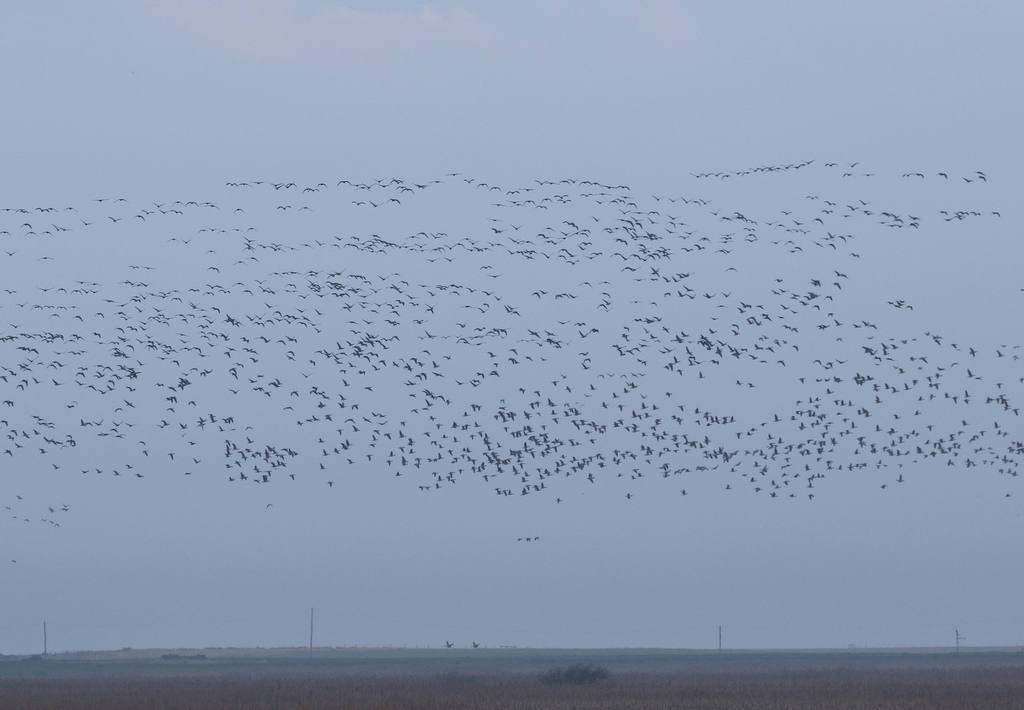
We drove round to the other side of the grazing marshes to see if we could find where the Barn Owl had gone. There was no sign of it here either. We did get a glimpse of a second Barn Owl out hunting, a darker bird, but it dropped down behind the reeds out in the middle before everyone could see it and didn’t reappear. We drove back inland, round via some other sites where Barn Owls like to hunt, but there was no sign of any – they must not be hungry enough to come out feeding in the daylight at the moment.
It was starting to get dark now, so we headed up to the wood. We stood on the edge for a few minutes and looked out over the meadows below, where a Water Rail was squealing. Then the first Tawny Owl starting hooting behind us, so we walked back into the trees. We stopped on the corner of the track and waited.
After a few minutes, a female Tawny Owl called behind us. Then we heard another male hooting in the distance. Finally, a third male Tawny Owl started hooting close to us. We stood and listened for a while and eventually this one flew towards us. It landed in a tree in front of us briefly, but it looked like it saw us and flew across the track and deeper into the trees. It seemed like the opportunity might have passed.
Then we heard the Tawny Owl hooting again and it seemed to be coming from the edge of the track a little further down. We walked along and scanning the branches managed to find it perched high in tree above us. We managed to get it in the scope, silhouetted against the last of the light. It stayed there for several minutes, first hooting, then calling, before dropping back through the trees in the direction it had first come. As we walked back to the car, we could still hear it hooting from deeper in the wood.
It was a great way to end our first day, watching Tawny Owls at dusk. But it was getting dark now, so it was time to call it a day.
















